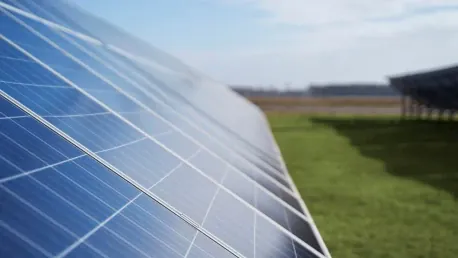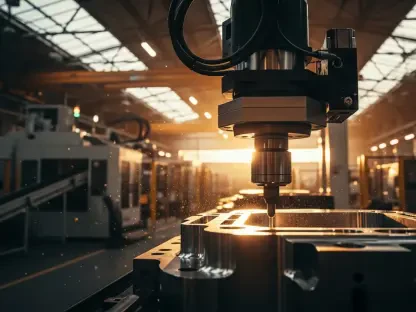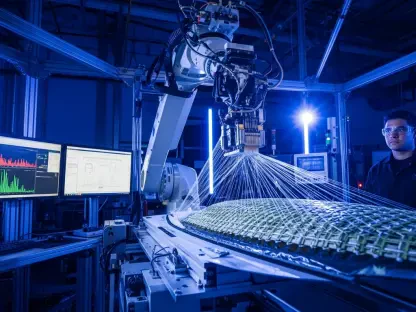Recent developments in the US solar industry demonstrate a concerted effort by the government to bolster domestic manufacturing capabilities. The introduction of significant incentives and regulatory changes aims to expand the country’s production capacity, addressing various supply chain stages from raw materials to final products. This article dives into these changes and their implications for the solar sector.
Catalysts in Policy: The Inflation Reduction Act of 2022
Introduction of Production and Investment Tax Credits
The Inflation Reduction Act (IRA) of 2022 has been a game-changer for the US solar industry. It introduces generous production tax credits for manufacturers, along with investment tax credits for project developers who use domestically sourced materials. These incentives have ignited a surge of investments from prominent global solar companies, particularly in later stages of the supply chain such as module and cell production. By providing financial encouragement, the IRA aims to reduce dependency on foreign imports and foster a more self-reliant domestic solar industry.
Since the enactment of the IRA, the US has witnessed an influx of capital aimed at establishing and expanding solar manufacturing facilities. This trend is reshaping the landscape, attracting both new and existing players to ramp up their production capabilities. The allure of these tax credits is significant, prompting many to anchor their operations on American soil. As these investments materialize, they are expected to drive both economic growth and job creation, while also enhancing national security by developing a robust, self-sufficient solar supply chain.
Impact on Investment Trends
The impact of the IRA on investment trends within the solar industry has been profound. Companies are now more willing to commit to large-scale projects, supported by the promise of long-term financial benefits. This shift is not merely about increasing production but also about ensuring sustainability and quality within the entire manufacturing process. The policy is designed to encourage the use of advanced technologies and high standards of production, anticipating that these moves will yield dividends in terms of efficiency and environmental stewardship.
Furthermore, the increased investment has catalyzed innovations in solar technology, prompting advancements that might have taken much longer without such robust support. The incentivization of domestic production has also encouraged ancillary industries to expand, creating a ripple effect across the broader manufacturing landscape. From a strategic standpoint, these investments are crucial for positioning the US as a leader in renewable energy technologies, not only meeting domestic demand but also enhancing its competitive edge on the global stage.
Advanced Manufacturing Investment Credit: Strategic Expansion
Overview of CHIPS ITC
The Advanced Manufacturing Investment Credit, commonly referred to as the CHIPS ITC, provides a 25% credit on qualified properties in advanced manufacturing facilities. Properties eligible for this credit must be placed in service after December 31, 2022, and related to construction projects initiated post-CHIPS and Science Act enactment on August 9, 2022. This financial incentive is a strategic measure aimed at bolstering infrastructure investments in cutting-edge manufacturing zones, essential for both solar and semiconductor industries.
The CHIPS ITC’s design aligns with broader governmental goals of repatriating critical manufacturing processes back to the United States. Given the importance of semiconductors in a myriad of consumer goods and technologies, the establishment and expansion of domestic production facilities are seen as pivotal moves. The 25% credit serves as a significant inducement for companies to invest in the construction of advanced manufacturing plants, thereby creating high-value jobs and fostering regional economic development.
Enhancing Semiconductor Manufacturing
Treasury Secretary Janet L. Yellen underscored the Biden-Harris administration’s commitment to repatriating semiconductor manufacturing, a sector integral to the stability and innovation within the tech landscape. Semiconductors are vital components for a vast array of electronics, and their production is crucial for maintaining the steady supply of consumer goods. By focusing on repatriating this industry, the US aims to insulate itself from the geopolitical and economic risks associated with over-reliance on foreign sources.
The CHIPS ITC plays a critical role in this strategic pivot, encouraging investments in new and existing facilities dedicated to semiconductor production. This move is expected to catalyze advancements in the sector, boosting national security by ensuring a domestic supply of these critical components. The emphasis on semiconductor manufacturing also aligns with broader national policy goals of sustaining technological leadership and fostering innovation.
Insights from the Solar Energy Industries Association (SEIA)
SEIA’s Response to Expanded Section 48D
The SEIA has expressed strong support for the expanded scope of Section 48D, now encompassing advanced facilities and equipment used for semiconductor production. This policy adjustment is viewed as a vital step toward closing existing gaps in the supply chain, particularly in the production of ingots and wafers. These components are crucial not only for the solar sector but also for a myriad of technological applications. The SEIA’s advocacy underscores the critical role that semiconductors and foundational materials play in the broader energy and technology ecosystems. By supporting the expanded Section 48D, the SEIA is aligning with governmental efforts to build a more resilient and diversified supply chain. This alignment is essential for achieving long-term sustainability and competitiveness in the global market.
The SEIA’s endorsement highlights the importance of comprehensive and inclusive policy frameworks that address varied aspects of manufacturing. By supporting the expanded Section 48D, the SEIA is aligning with governmental efforts to build a more resilient and diversified supply chain. This alignment is essential for achieving long-term sustainability and competitiveness in the global market. The association’s positive reception signals industry readiness to collaborate with policymakers on fostering a robust domestic manufacturing sector.
Addressing Supply Chain Challenges
Despite the IRA’s positive impact, the US solar industry still grapples with challenges such as inadequate ingot and wafer production. These components are essential for a fully localized supply chain. SEIA and other industry stakeholders continue advocating for comprehensive policy support to address these persistent issues. The gap in production capacities for these critical upstream materials poses a significant bottleneck, potentially slowing down the anticipated growth and scaling of the entire solar manufacturing sector.
To bridge this gap, there is a concerted call for more targeted investments and incentives at these initial stages of the supply chain. Industry experts emphasize that addressing these foundational elements is crucial for ensuring the downstream success of module and cell production. Without sufficient ingot and wafer production, the entire value chain risks becoming dependent on external suppliers, undermining the goals of self-reliance and sustainability. SEIA’s consistent lobbying efforts reflect a recognition of these challenges and a proactive approach to seeking solutions.
Current Landscape of the US Solar Supply Chain
Announcements and Actual Progress
Since the IRA’s implementation, plans for a combined 21 GW of wafer and 10 GW of ingot production have surfaced. However, the physical realization of these capacities remains limited, with only 3.3 GW of the announced ingot and wafer production currently under construction. This lag highlights the need for sustained policy and industry support. While the announcements reflect a commendable commitment to expanding upstream production, the slow pace of construction indicates that more needs to be done to accelerate these projects.
The disparity between announced capacities and actual progress underscores the complexities involved in scaling up manufacturing infrastructure. Factors such as lengthy permitting processes, logistical challenges, and initial capital expenditures can hinder rapid deployment. Addressing these bottlenecks requires a coordinated effort between government and industry stakeholders. Ensuring timely and efficient implementation is pivotal for meeting the growing demand for solar technologies and achieving long-term sustainability goals.
Looking Forward: Scaling Up Manufacturing
The existing announcements indicate a significant potential for growth in US solar manufacturing. To capitalize on this potential, concerted efforts are required to advance the construction and operationalization of these facilities. Addressing upstream production capabilities is crucial for meeting the rising demand for solar energy. Policy enhancements, streamlined regulatory processes, and improved access to financing can collectively contribute to this objective, fostering an environment conducive to large-scale manufacturing development.
Strategic investments and focused governmental support can bridge the gap between announced plans and physical realities. Engaging local communities, leveraging technological advancements, and aligning industry expertise with policy initiatives are essential for achieving this ambition. Emphasizing quality and sustainability in manufacturing processes can further enhance the global competitiveness of US-made solar products. By addressing these key areas, the US can establish a formidable and self-reliant solar manufacturing ecosystem, reflective of its renewable energy ambitions.
Economic and Strategic Implications
Job Creation and Innovation
The new regulations are anticipated to generate well-paying jobs and spur innovation within the US. By positioning itself as a competitive player in the global solar market, the country aims to secure economic growth while advancing its renewable energy goals. The creation of jobs, both directly within the solar manufacturing sector and indirectly through ancillary industries, is expected to have a broad positive impact on the economy. Additionally, fostering innovation within the industry can lead to breakthroughs that enhance efficiency, reduce costs, and drive further adoption of solar technologies.
Investments in research and development, coupled with a supportive regulatory framework, can cultivate a dynamic ecosystem where innovation thrives. The influx of skilled jobs promotes community development and economic resilience, particularly in regions hosting major manufacturing facilities. As the solar industry evolves, continuous innovation ensures that the US remains at the forefront of technological advancements, setting global standards and leading by example. These combined efforts contribute to a robust industrial renaissance, reinforcing the role of renewable energy in the nation’s economic future.
National Security Considerations
The strategic expansion of domestic manufacturing capabilities for semiconductors and solar technology is also driven by national security concerns. Ensuring a robust, self-reliant supply chain is viewed as essential for maintaining economic stability and reducing dependency on foreign sources. By developing local production capacities, the US can mitigate risks associated with global supply chain disruptions, safeguarding critical industries. This strategic vision aligns with broader efforts to enhance national resilience in the face of evolving geopolitical and economic challenges.
Strengthening domestic manufacturing also reinforces the country’s sovereignty over essential technologies and materials. National security considerations extend beyond immediate economic benefits, encompassing the safeguarding of intellectual property, sustainability of essential services, and preservation of critical infrastructure. By fostering a self-sufficient supply chain, the US aims to build a foundation of economic and technological independence, contributing to long-term stability and security.
Industry and Policy Collaboration: A Path Forward
Continuing Governmental Support
Ongoing governmental support remains crucial for the sustained growth of the US solar industry. Policies that address the entire supply chain, from raw materials to finished products, are necessary to build a resilient and comprehensive manufacturing ecosystem. This holistic approach ensures that no stage of the supply chain is neglected, fostering a balanced and integrated manufacturing landscape. Continued governmental advocacy and support can provide the necessary resources and incentives to maintain momentum and achieve long-term sustainable growth.
Engaging with industry stakeholders in policy formulation and implementation enhances the effectiveness of these initiatives. Collaborative efforts can identify and address potential challenges, ensuring that policies are adaptable and responsive to evolving industry needs. By maintaining a proactive and supportive stance, the government can facilitate industry advancements, encourage innovation, and promote a favorable business environment. The shared objective of a thriving and self-reliant solar industry underscores the importance of sustained collaboration and support.
SEIA’s Role and Advocacy
Recent advancements in the American solar industry showcase a dedicated effort by the government to enhance domestic manufacturing. Through substantial incentives and regulatory updates, the aim is to expand the nation’s production capacity, covering the entire supply chain from raw material acquisition to final product assembly. These initiatives not only seek to stabilize and grow the industry but also aim to boost national security by reducing reliance on foreign suppliers. The focus on developing a robust internal supply chain is expected to create new jobs, spur technological innovation, and lower production costs over time.
Furthermore, these regulatory and financial measures could contribute to a more sustainable and eco-friendly energy landscape. By addressing potential bottlenecks and fostering a self-sufficient production environment, the government’s strategy appears finely tuned to navigate current and future challenges in the solar sector. This article will explore these developments and their broader implications for the renewable energy landscape in the United States.









